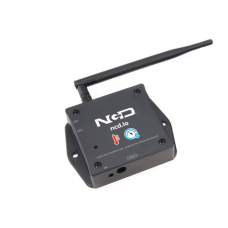IoT Long Range Wireless Pressure and Temperature Sensor
IoT Long Range Wireless Pressure and Temperature Sensor
Our long range wireless enterprise series sensors are an easy to use and reliable start to any data aggregation application. This video will demonstrate how they work, what they do, and how to use them.
IoT Long Range Wireless Pressure and Temperature Sensor
Introducing NCD’s Long Range IoT Wireless Temperature Barometric Pressure Sensor, boasting up to a 28 Mile range using a wireless mesh networking architecture. Incorporating a MS5803 pressure sensor, transmits highly accurate data at user-defined intervals. It measures pressure and temperature with user configurable resolution at user defined intervals while sleeping during the time when it is not measuring or sending data.
Moreover, it takes baseline pressure input from user to determine subsequent change in altitude. This IoT Wireless Temperature Barometric Pressure Sensor also takes baseline altitude from user to determine relative pressure with respect to that altitude. Default resolution, sleep time, baseline pressure and baseline altitude are shown in Table 1.
Powered by just 2 AA batteries and an operational lifetime of 500,000 wireless transmissions, a 10 years battery life can be expected depending on environmental conditions and the data transmission interval. Optionally, this sensor may be externally powered.
With an open communication protocol this sensor can be integrated with just about any control system or gateway. Data can be transmitted to a PC, a Raspberry Pi, to Microsoft Azure® IoT, or Arduino. Sensor parameters and wireless transmission settings can be changed on the go using the open communication protocol providing maximum configurability depending on the intended application.
The long range, price, accuracy, battery life and security features of Wireless Temperature Barometric Pressure Sensor makes it an affordable choice which exceeds the requirements for most of the industrial as well as consumer market applications.
Receiving Data From Long Range IoT Wireless Temperature Barometric Pressure Sensor
This IoT Wireless Temperature Barometric Pressure Sensor device sends data periodically, based on user-preset timing intervals. Data transmissions include battery level, signal strength, payload, firmware version, sensor type, and device serial number. Please see the Resources section to see detailed information on the data structure of this device. This wireless transmitter needs a receiver. There are many options available for receiving data from NCD transmitters. We highly recommend using our USB Modem (available during purchase) so you can monitor this device and use our LabVIEW software for changing device settings. Using our long-range USB wireless modem, users can expect easy operation over a virtual COM port at 115.2K baud. Optionally, we offer a Wireless receiver that operates over ethernet. Data from NCD sensors will appear over TCP/IP on port 2101. Simply open a TCP/IP socket, port 2101, to the IP address of the Ethernet modem and see your data stream in to your local area network.
Now Supporting Microsoft Azure® IoT
We’ve been working with Microsoft engineers to post data from our sensors to Azure®. If you need help integrating this sensor into Azure®, please let us know and we will work with you to get you connected!

We take software samples seriously! Be sure to to check out the resources section of our web site to see code samples for Raspberry Pi, Visual Studio, LabVIEW, Arduino, Python, and more. We can help you post data to your Azure IoT account with some of our tutorials!
Applications:
-
In House Temperature Barometric Pressure monitoring
-
Temperature Barometric Pressure Monitoring In the Hospitals
-
In Medical Application
-
In Medicine or Pressure Temperature Critical Storage Units
-
HVAC Air Pressure and Temperature Monitering
-
Pressure And Temperature Dataloggoing Applications
-
Cloud Weather Monitoring Monitoring For AWS/Azure

900HP-S3B Industrial Wireless Mesh
Long-Range Wireless Mesh networking is our favorite of all wireless communication technologies. This is the ONLY communications technology NCD recommends on the factory floor, operating at a safe 900MHz. Mesh technology will hop data from one location to another to reach its intended destination, users do not need to do anything other than make sure wireless modules stay within hopping range of each other. We use the Digi 900HP-S3B module in our products, as this is the best the industry has to offer. With a 2 mile range between modules and up to 8 hops, it is possible to cover 16 miles of wireless territory using this technology. Using high-gain antennas, this module is capable of communicating to a remote module up to 28 miles away.
Features
- Industrial Grade Sensor Long Range Wireless Pressure Temperature Sensor
- Operating Range 0 to 14000 mbar, -40°C [-40 °F] to +85 °C [185 °F]
- Configurable Internal Calculation Pressure Resolution 0.012 to 0.065 mbar
- Configurable Internal Calculation Temperature Resolution 0.002 to 0.012 °C
- Accuracy ±2.5 mbar, ±2 °C
- Absolute Pressure, Relative Pressure and Relative Altitude Change outputs
- 2 Mile Range with On-Board Antenna
- Superior LOS Range of up to 28 miles with High-Gain Antennas
- Interface to Raspberry Pi, Microsoft Azure,AWS, Arduino and More
- Example Software for Visual Studio and LabVIEW
- Wireless Mesh Networking using DigiMesh®
- 256 Sensor Nod e per Network
- Open Communication Protocol for custom interfacing applications
- Small Form Factor Wireless Sensor (3×3 inch)
- Two modes of Operation
- Configuration mode for Sensor and X-bee Settings
- Factory Default Option using combination of hardware buttons
- Power efficient Built-in Sleep mode
- User Configurable Sleep duration
- Up to 500,000 Transmissions from 2 AA Batteries
- X-bee API mode use for reliable communication
- Improved reliability incorporating Re try feature in case of packet loss
- Real time battery status
Enter the code in the box below:


